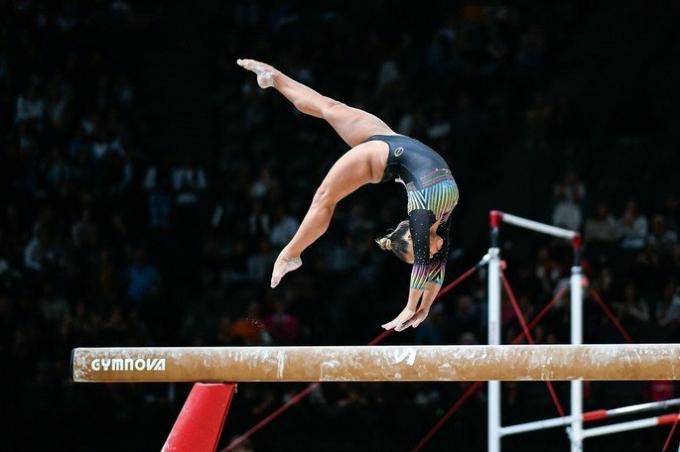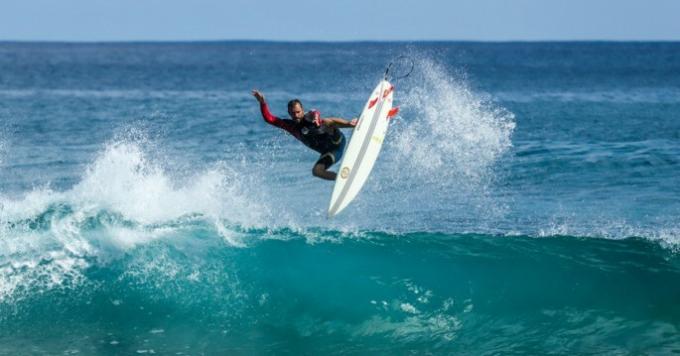Technical-combinatory sports are individual or collective sports, in which athletes perform a sequence of movements and are evaluated by a panel of judges. Judges rate the difficulty of execution and the beauty of the movements, as well as the precision with which they are performed.
Examples of technical-combinatory sports:
- artistic gymnastics
- Rhythmic gymnastics
- Acrobatic gymnastics
- Skateboard
- Surfing
- Synchronized swimming
- Diving
- figure skating
1. artistic gymnastics

Artistic gymnastics, also called Olympic gymnastics, is a sequence of movements on the ground or on the following apparatus: pommel horse, rings, parallel bars, horizontal bars, uneven bars and balance.
The male and female races are different. Performed within a space of 12m x 12m meters, in the men's floor competitions there is no background music, while in the women's there is.
Male gymnasts perform events in 70 seconds with the following equipment: rings, bars, pommel horse, vault and floor.
The evidence for women gymnasts, in turn, lasts 90 seconds and consists of asymmetrical parallel exercises, jumping on the table, floor and balance beam.
Artistic gymnastics is an ancient practice. It was the sport practiced by the Greeks to achieve physical perfection, in addition to what was also practiced in military training.
In Brazil, artistic gymnastics began in the South, brought by European immigrants.
Brazilian gymnast Daiane dos Santos, who won two silvers and three bronzes, created two movements that became known by their names: the pike double twist (Dos Santos I) and the stretched double twist (Dos Santos II).
It is an Olympic sport since the 1st edition of the Olympic Games, in 1896.
2. Rhythmic gymnastics
Sports rhythmic gymnastics originated in artistic gymnastics, arising from the insertion of exercises and mainly music, which brought rhythm to the modality.
In rhythmic gymnastics, movements are performed in sync with the music played during the performance.
The evidence can be individual or in sets composed of 5 gymnasts. They are performed within a space of 13m x 13m meters.
The times for the presentation of the tests are between 1min15s and 1min30s, in individual tests, and between 2min15s and 2min30s, in group tests.
Five devices are used in this gymnastics modality: hoop, ball, rope, mace and ribbon. In the Olympic Games, only 4 devices are used.
It has been an Olympic sport since 1984, in which only female gymnasts participate.
3. Acrobatic gymnastics
Acrobatic gymnastics is a gymnastics modality in which movements are performed without the use of apparatus. The technical movements of this modality are the mounts and dismounts.
In presentations, in order to ensure harmony in the execution of movements, gymnasts assume different functions. The functions are as follows:
- steering wheel: gymnast who is at the top of the structure.
- base: gymnast who supports and carries the shuttlecock.
- intermediate: gymnast who performs a little of the role of each of the above gymnasts.
The events can be in pairs or in groups, of 3 gymnasts in the women's events, and 4 gymnasts in the men's events.
In doubles competitions between male and female gymnasts, the man has the base function. In men's quartet competitions, 2 gymnasts act as intermediaries.
The practice of acrobatic gymnastics is quite old, probably originating in 2300 BC. W.
This modality is not yet part of the Olympic Games.
4. Skateboard
Skateboarding is a sport in which athletes do tricks and jumps while balancing on a skateboard. The tests are performed on a track, with or without obstacles.
The first skateboards appeared in the United States. In the first half of the 20th century, the upper parts of scooters were removed and used as a kind of skateboard, but it was practiced sitting down.
In the 1950s, when surfers couldn't catch waves, they started putting wheels on surfboards and having fun with that equipment.
In Brazil, skateboarding arrived in the 60s, in Rio de Janeiro.
The Brazilian Skate Confederation, responsible for regulating the rules of the sport in Brazil, was founded in 1999.
The main modalities of skateboarding are: street, park, downhillspeed, freestyle, mini-ramp and vertical.
Sport was part of the Olympic Games, for the first time, in 2021, with street and park modalities. In this participation, Brazil won 2 silver medals.
5. Surfing

Surfing is a very old sport that emerged around 3000 BC. W. There are records that indicate that it was created by the inhabitants of Polynesia, while others indicate that it was created by Peruvian fishermen.
The judges' evaluation considers the following elements to score a wave:
- commitment and degree of difficulty;
- innovative and progressive maneuvers;
- combination of major maneuvers;
- variety of maneuvers;
- speed, power and fluidity.
Scoring a wave can use the following scale:
- 0 to 1.9: bad
- 2.0 - 3.9: reasonable
- 4.0 - 5.9: average
- 6.0 - 7.9: good
- 8.0 - 10.0: excellent
In Brazil, surfing emerged in Baixada Santista in the 1930s.
6. Synchronized swimming
Synchronized swimming, or artistic swimming, is a water sport for women. In it, the athletes perform movements, which include acrobatics and jumps, to the musical rhythm.
The evaluation considers the way the athletes walk to the pool, the choreography performed and the facial expressions, which must show contentment, despite the effort made by the athletes.
There are several types of tests:
- tests with technical routine, which includes mandatory movements
- free routine, where there is no restriction on its execution
- combo routine, which is a combination of the two proofs above.
In this sport, athletes wear a swimsuit and a nose clip to prevent them from inhaling water during presentations.
Pools must be at least 20m x 30m and 3m deep. In addition, they contain underwater speakers, which transmit the songs choreographed by the athletes.
Some movements of synchronized swimming are: fishtail, albatross with twirl and spaccato.
Synchronized swimming is an Olympic sport. Its first demonstration at the Olympic Games was made in 1948.
7. Diving
Diving is a sport in which athletes jump into a pool from a trampoline. Pools must be at least 5 meters deep.
Each jump is evaluated with points from 0 to 10. 0 corresponds to a completely failed jump and 10 to an excellent jump.
The points consider the technique of the following steps:
- starting position;
- race, which is running and jumping on the tip of the trampoline;
- exit, which is the trampoline jump;
- flight, which comprises the somersault in the air;
- Prohibited, which is diving.
Men's individual or synchronized events must contain 6 jumps, while women's events must contain 5 jumps.
The sport was part of the Olympic Games for the first time in 2000.
8. figure skating

Figure skating is a sport that includes dance elements in ice skating.
There are 2 pieces of equipment that are essential for this sport: skates and clothing.
The skates are made of leather and have a steel blade at the tip, an essential element for performing jumps. The clothing used is designed to match the choreography performed by the skaters.
The tests are carried out on a 60m x 30m track.
Figure skating emerged in the 19th century, but the act of skating already existed 3,000 years ago. In Brazil, the practice of figure skating began in the 60s, but its participation in international championships only started in 2007.
The sport was part of the Olympic Games for the first time in 1908. Since 1924 it has been part of the Winter Olympic Games.
Read too:
- artistic gymnastics
- Rhythmic gymnastics
- Acrobatic gymnastics
- Sport types: Invasion, Mark, Accuracy, Combat, Net and Wall
Technical-combinatory sports: what they are and 8 examples.All Matter, [n.d.]. Available in: https://www.todamateria.com.br/esportes-tecnicos-combinatorios/. Access at:
See too
- Fitness
- artistic gymnastics
- Acrobatic gymnastics
- Brand sports: what they are and 12 examples
- Sport types: Invasion, Mark, Accuracy, Combat, Net and Wall
- Rhythmic gymnastics
- Olympics (Olympic Games)
- Athletics

